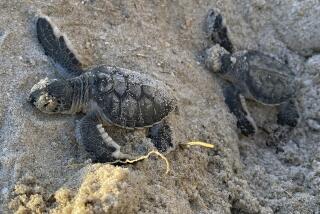Nicaraguan Police Protect Sea Turtles
- Share via
CHOCOCENTE, Nicaragua — Nicaragua has deployed machine gun-toting police force dressed in battle fatigues and combat boots to make this Pacific coast beach safe for sea turtles.
Each year, guided by moonlight, tens of thousands of sea turtles crawl out of the surf to lay hundreds of thousands of eggs in the beach at Chococente and elsewhere along the coast.
Traditionally, despite a government ban, the sea turtles, among the world’s endangered species, were greeted by thousands of Nicaraguans who scooped the small, white eggs into gunny sacks as quickly as they were laid.
The poachers, most of them peasant families, would sell the eggs on the spot to a handful of middlemen who would load the sacks on trucks and drive off to sell the eggs--which are considered a delicacy and rumored to be an aphrodisiac--to local restaurants or to export them.
“Not a single nest was left untouched,” said Jose Morales, head of the fauna department of the Nicaraguan Natural Resources and Environment Institute, known as Irena.
This year, however, the situation at Chococente and other beaches is different.
A special force of 20 heavily armed policemen patrol the beach at night--along with Irena officials, local ecologists and students--putting teeth in the extended government ban on the sea turtle egg hunt.
A government decree has banned turtle egg hunting from July 1, 1990, through Jan. 31, 1991--the entire season--at Chococente and five other Pacific coast beaches that are most frequented by the turtles. The ban at other beaches began Oct. 1.
While the new measures--under a government program dubbed “Let Me Live”--has increased chances for the sea turtles, the program is not universally supported.
Local villagers have accused the government of taking food from their mouths.
“This is a great injustice,” Simona Cruz, who sells soft drinks and cigarettes in the nearby village of El Astillero, said of the government ban on turtle egg hunting. “If we don’t work, we don’t eat.”
Thus far this year police at Chococente beach have had no clashes with poachers and their biggest battle appeared to be against boredom during their assignment, which lasts several weeks. According to one police source, a recent police contingent left Managua for Chococente armed with playing cards, cassette decks and inflatable rafts.
However, Maria del Socorro Martinez, a biologist with the Assn. of Nicaraguan Biologists and Ecologists who is working with Irena in the sea turtle program at Chococente, said some local residents have threatened that if the ban is not lifted, they will use fishing nets to capture the 90-pound turtles before they reach the beach.
On a recent afternoon, Martinez showed visiting journalists a turtle that had washed up on Chococente beach.
Turtle blood could be seen in the wet sand near the shore. Two large gashes had been cut in its side where fisherman had scooped out its eggs before tossing the dead turtle overboard.
“We’re starting to see a turtle drought,” she said, explaining that of every 1,000 turtles that are hatched on the beach, only three survive to adulthood.
Morales said, however, that Irena is considering relaxing the turtle ban to allow a limited number of local peasants to hunt eggs on select days, in order to ease tensions and boost local support for the program.
He said that each season there are six to eight “landings”--when up to 4,000 turtles arrive at Chococente to lay their eggs. In past years an equal number of people took away virtually every egg laid during the landings, which last about a week each.
Under the proposed compromise, 200 locals would be allowed to hunt eggs, but only on the first day of each landing, Morales said.
“We’re trying to reach a compromise,” Morales said. “If we close off the area completely it could provoke a conflict.”
More to Read
Sign up for Essential California
The most important California stories and recommendations in your inbox every morning.
You may occasionally receive promotional content from the Los Angeles Times.













